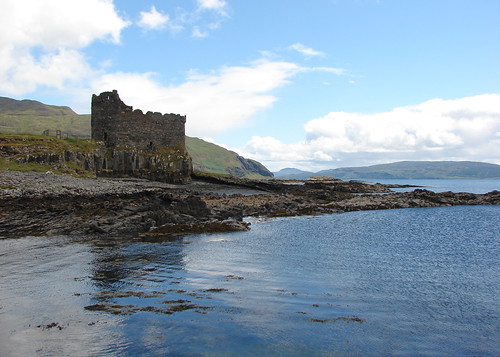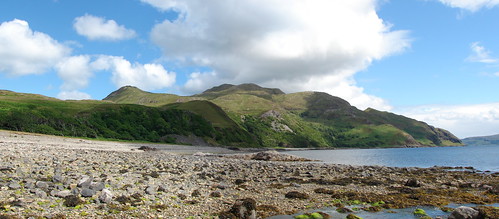Ardnamurchan - Kilchoan and Mingary Castle
Kilchoan, the most Westerly village on mainland Great Britain, is the largest settlement on the Ardnamurchan peninsula and pretty much the closest thing to the city lights that you'll find for miles; I mean, it has a shop, a garage, a hotel and even a tourist information office. It also has a car-ferry terminal from where you can catch the boat over to Tobermory on Mull and, with seven crossings a day during the Summer months, it's obviously a popular route. The shop, a life-line to anyone staying in the area, is pretty well stocked and not over-priced and has a very decent range of beers and wines to pass away the solitude of cottage life.
We drove on down to the tourist information office, which lies on the road down to the ferry terminal, and had a bit of lunch in the small café in there. It wasn't bad either - home-made soup, rolls, buns, etc.; what else do you need for a quick snack to keep you going in the middle of the day? From there it's a short drive down to the pier where there are some good views out over the Sound of Mull and back over to the ruins of Mingary Castle, which lies about a mile round the bay from Kilchoan.
Built in the 13th century for the MacIains of Ardnamurchan, the castle sits atop a rocky outcrop in Kilchoan Bay overlooking the entrance to Loch Sunart and the Sound of Mull. Like most Scottish castles of that era, it's had a pretty eventful history from being used by James IV in the late 15th century to help him suppress the MacDonalds, the Lords of the Isles and in the early 16th century it was besieged and taken by the MacDonalds of Lochalsh.
In 1588 the Macleans of Duart on Mull captured the castle with some involvement from a ship of the Spanish Armada en-route back home after their failed invasion of England. In the 17th century the castle was captured during the Wars of the Covenant and during the 1745 Jacobite rebellion it served as a government garrison. Today, it's in pretty poor repair and access to the interior of the castle is restricted for fear of causing someone an injury.
Getting to the castle involves either a trek round the shore from the pier or you can drive out just East of the village where you'll find a small track leading down a place where you can park and then walk down to the castle. Needless to say, we chose the easy route as the weather wasn't that great and we fancied wandering further along towards Ben Hiant, which is the highest peak in the area.
After a bit of clamber down to the beach from the castle and pottering about a bit on the rocks, we did indeed wander further along the track towards Ben Hiant and the weather had brightened up a bit so we got some good views of the hill and across to the Island of Mull. It's a pity it wasn't as nice earlier or we'd have probably gone to the top of the hill as the views out over the Sound of Mull are supposed to be excellent.
We drove on down to the tourist information office, which lies on the road down to the ferry terminal, and had a bit of lunch in the small café in there. It wasn't bad either - home-made soup, rolls, buns, etc.; what else do you need for a quick snack to keep you going in the middle of the day? From there it's a short drive down to the pier where there are some good views out over the Sound of Mull and back over to the ruins of Mingary Castle, which lies about a mile round the bay from Kilchoan.
Built in the 13th century for the MacIains of Ardnamurchan, the castle sits atop a rocky outcrop in Kilchoan Bay overlooking the entrance to Loch Sunart and the Sound of Mull. Like most Scottish castles of that era, it's had a pretty eventful history from being used by James IV in the late 15th century to help him suppress the MacDonalds, the Lords of the Isles and in the early 16th century it was besieged and taken by the MacDonalds of Lochalsh.
In 1588 the Macleans of Duart on Mull captured the castle with some involvement from a ship of the Spanish Armada en-route back home after their failed invasion of England. In the 17th century the castle was captured during the Wars of the Covenant and during the 1745 Jacobite rebellion it served as a government garrison. Today, it's in pretty poor repair and access to the interior of the castle is restricted for fear of causing someone an injury.
Getting to the castle involves either a trek round the shore from the pier or you can drive out just East of the village where you'll find a small track leading down a place where you can park and then walk down to the castle. Needless to say, we chose the easy route as the weather wasn't that great and we fancied wandering further along towards Ben Hiant, which is the highest peak in the area.
After a bit of clamber down to the beach from the castle and pottering about a bit on the rocks, we did indeed wander further along the track towards Ben Hiant and the weather had brightened up a bit so we got some good views of the hill and across to the Island of Mull. It's a pity it wasn't as nice earlier or we'd have probably gone to the top of the hill as the views out over the Sound of Mull are supposed to be excellent.




No comments:
Post a Comment